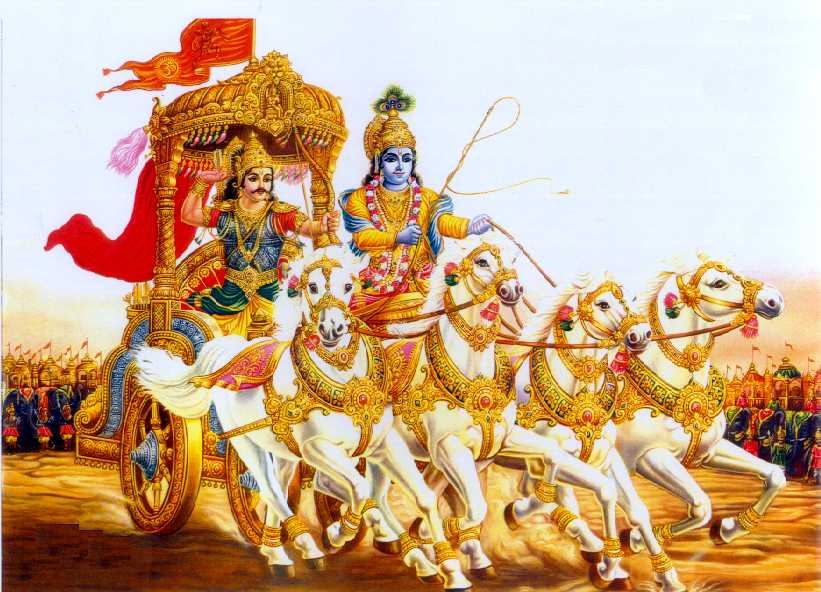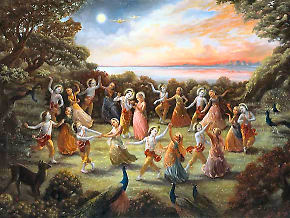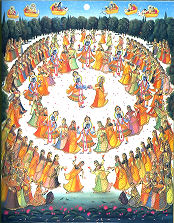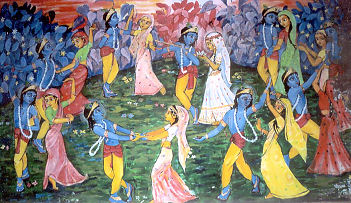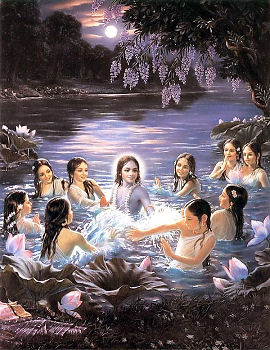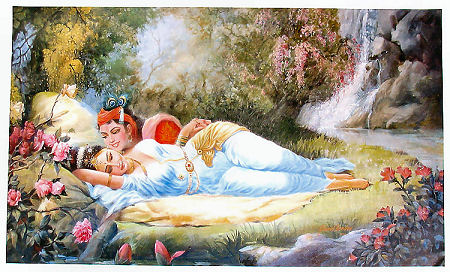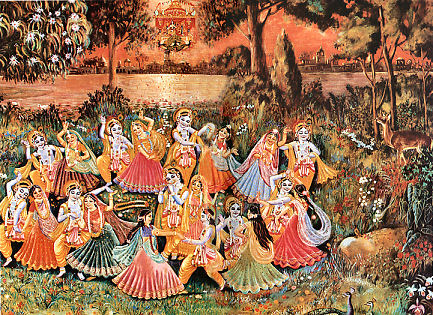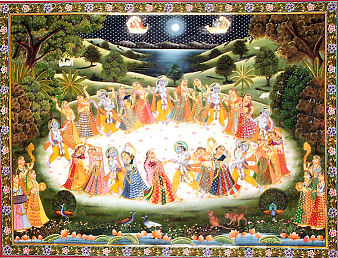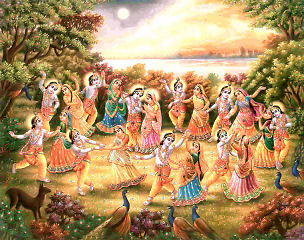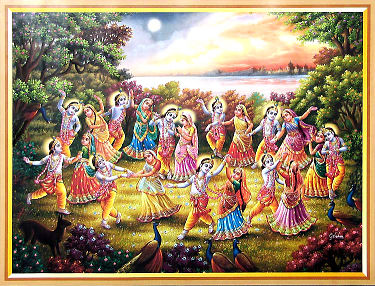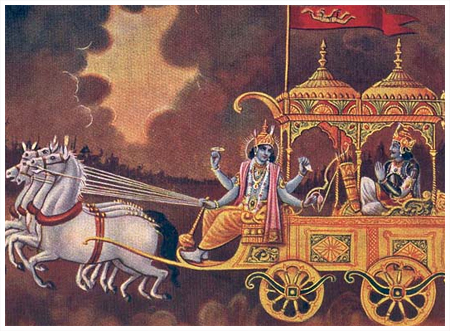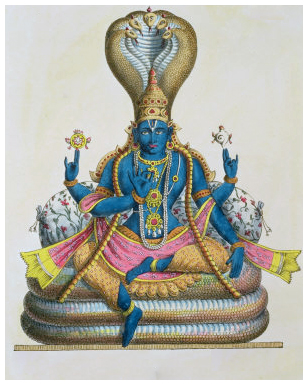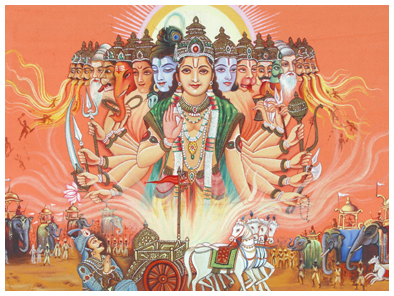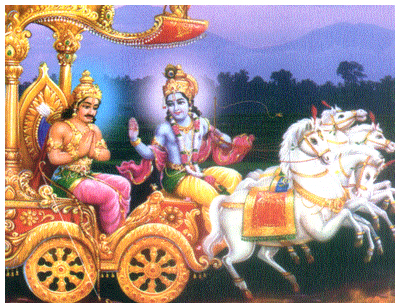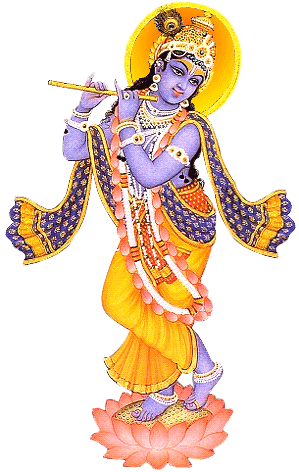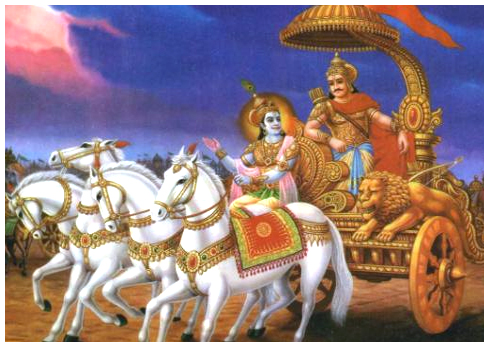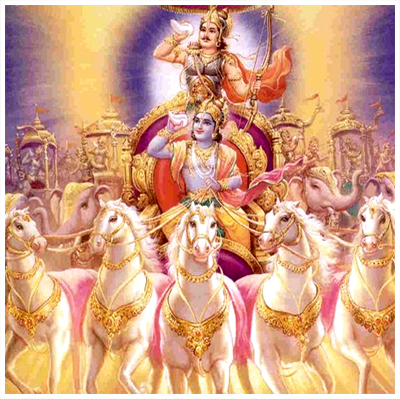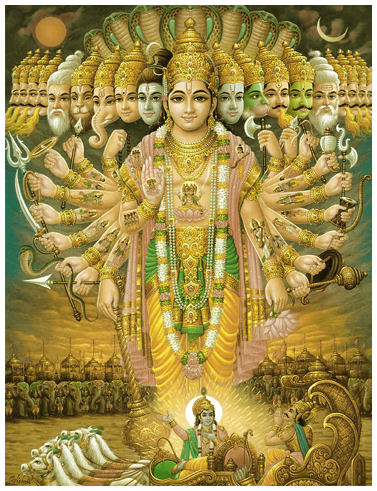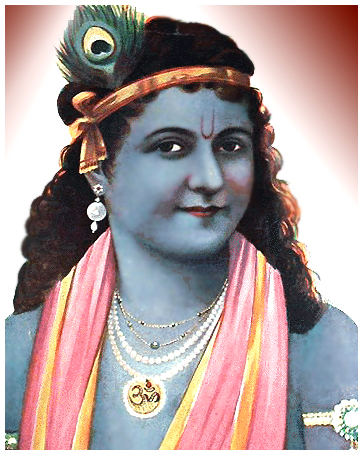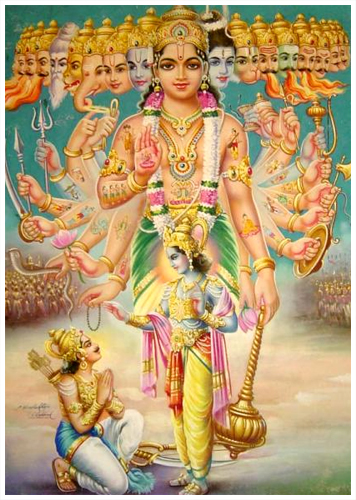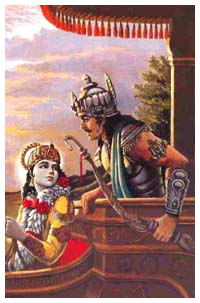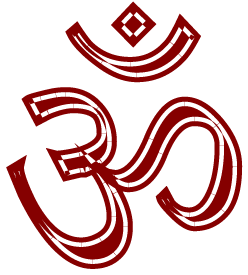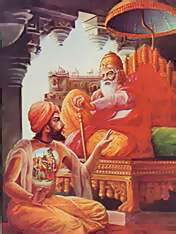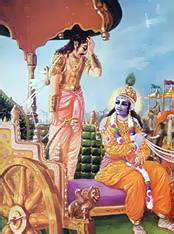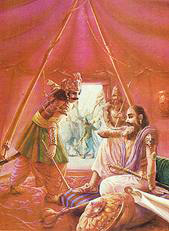 |
|
|
|
|
Hindu Of UniverseBhagavad GitaBhagavad Gita is part of the epic poem Mahabharata, located in the Bhisma-Parva chapters 23–40. A core sacred text of Hindu (Vedic) religion and philosophy, the Bhagavad Gita, often referred to as the Gita, is a summation of the Vedic, Yogic, Vedantic and Tantric philosophies. The Bhagavad Gita, meaning "song of the Lord", refers to itself as a 'Yoga Upanishad' and is sometimes called Gītopanişad. During the message of Gita, Lord Krishna proclaims that he is God Himself (a Bhagavat, or all-embracing personal god). In order to make Arjuna believe this, he shows Arjuna his divine form which is described as timeless and leaves Arjuna shaking with awe and fear. It is not exactly clear when the Bhagavad Gita was written. Astronomical evidence cited in the Mahabharata itself put the date at 3137 BCE, ancient Indian historical texts (Puranas) suggest a date of about 1924 BCE and the bulk of modern scholars hold widely differing dates that occur after 1000 BCE. Bhagavad Gita in GeneralStarting in the middle of the Mahabharata immediately before the epic's major battle at the field of Kurukshetra, the Bhagavad Gita recounts the exchange between the warrior-prince Arjuna and his charioteer Krishna, a king who is considered an avatar of God, or God Himself. Arjuna hears the conch shells signaling the start of fighting as he and Krishna ride out. As he looks at the opposing armies and sees his relatives, teachers, and friends fighting on either side, he is heartsick at the thought of killing these beloved persons. He turns to Krishna for advice. Krishna counsels Arjuna, beginning with the tenet that since souls are immortal, their deaths on the battlefield are just the shedding of the body, which is not the soul. Krishna goes on to expound on the yogic paths of devotion, action, meditation and knowledge. Fundamentally, the Bhagavad Gita proposes that true enlightenment comes from growing beyond identification with the ego, the little self, and that one must identify with the truth of the immortal Self, the soul or Atman, the ultimate divine consciousness. Through dispassion the yogi, or follower of a particular path of yoga, is able to transcend his mortality and attachment for the material world and see the infinite. To demonstrate the infinity of the unknowable Brahman, Krishna temporarily gives Arjuna the cosmic eye and allows him to see Him in all his divine glory. He reveals that He is fundamentally both the ultimate essence of being in the universe and also its material body. Among the great sages and philosophers who have drawn inspiration from the Bhagavad Gita are Shri Chaitanya Mahaprabhu, who started the public singing of the "Hare Krishna" mantra, and Mahatma Gandhi, who bestowed spiritual legitimacy to non-violence through the Gita and interpreted the war of the Mahabharata as a metaphor for the conflicts that trouble all people at one time or another. The culminating message of the Gita was the inspiration for his struggle against British colonial rule. American physicist and director of the Manhattan Project J. Robert Oppenheimer, upon witnessing the world's first atomic blast in 1945, is reported to have misquoted "I am become Death, the shatterer of worlds," from the Bhagavad Gita 11, Verse 32. [2] The dynamic Swami Vivekananda, the follower of Shri Ramakrishna known for his seminal commentaries on the four yogas, Bhakti, Jnana, Karma and Raja Yoga, also drew from his knowledge of the Gita to expound on them. Swami Sivananda advises the aspiring yogi to read verses from the Bhagavad Gita every day. Paramahamsa Yogananda, writer of the famous "Autobiography of a Yogi," viewed the Bhagavad Gita as one of the world's most divine scriptures, along with the Four Gospels of Jesus. Bhagavad Gita as a Yoga ScriptureThe Gita addresses the discord between the senses and the intuition of cosmic unity. It speaks of the yoga of equanimity, a detached outlook. The term yoga covers a wide range of meanings, but in the context of the Bhagavad Gita it describes a unified outlook, serenity of mind, skill in action, and the ability to stay attuned to the glory of the Self (Atman), which is of the same essence as the basis of being (Brahman). According to Krishna, the root of all suffering and discord is the agitation of the mind caused by desire. The only way to douse the flame of desire is by stilling the mind through discipline of the senses and the intellect. However, abstinence from action is regarded as being just as detrimental as extreme indulgence. According to the Bhagavad Gita, the goal of life is to free the mind and intellect from their complexities and to focus them on the glory of the Self by dedicating one's actions to the divine. This goal can be achieved through the yogas of meditation, action, devotion and knowledge. Krishna summarizes the Yogas through eighteen chapters. There are four kinds of Yoga: Raja Yoga or psycho-physical meditation, Bhakti Yoga or devotion, Karma Yoga or selfless action, and Jnana (pronounced gyaan) Yoga or self-transcending knowledge. Other forms that exist today sprang up long after the Bhagavad Gita and Yoga Sutras and are all essentially forms of Raja Yoga. While each path differs, their fundamental goal is the same: to realize Brahman (the Divine Essence) as being the only truth, that the body is temporal, and that the soul (Atman) is infinite. Yoga's aim (nirvana, moksha) is to escape from the cycle of reincarnation through realization of oneness with the ultimate reality. Here are some quotations from Lord Krishna that make up history's first real yoga text and give comprehensive definitions of the four principle yogas: On The Goal Of Yoga"When the mind comes to rest, restrained by the practice of yoga, and when beholding the Self, by the self, he is content in the Self." (B.G., Chapter 6, Verse 20) | " He who finds his happiness within, his delight within, and his light within, this yogi attains the bliss of Brahman, becoming Brahman." On Karma YogaKarma Yoga is essentially acting, or doing one's duties in life as per his/her dharma or duty, without desire or expectation of reward - a sort of constant sacrifice of action to the Supreme. It is action done without thought of gain. In a more modern interpretation, it can be viewed as duty bound deeds done without letting the type of result affect your action. It is said that the results can be of 3 types, a. as aimed for, b. opposite of what is aimed for and c. a mixture of these. If one can perform his duties (as prescribed in the Vedas) without any anticipation of the result of his actions, he is bound to succeed. It includes, but is not limited to, dedication of one's chosen profession and its perfection to God. It is also visible in community and social service, since they are inherently done without thought of personal gain. Example: If one is playing tennis on the tennis court his duty is to play as well as he can. If he is a Karma Yogi, the loss of a few points will not hamper his enthusiasm and energy for the rest of the game, but if he is not then he will start getting tense, nervous, self-conscious, etc. and is then bound to make mistakes and lose anyway. This is a simple example of Karma Yoga for a layman. "With the body, with the mind, with the intellect, even merely with the senses, the yogins perform action toward self-purification, having abandoned attachment. He who is disciplined in yoga, having abandoned the fruit of action, attains steady peace..." (B.G. Chapter 5, Verses 11-12) On Nishkam Karma YogaLord Krishna advocates Nishkam Karma Yoga as the Yoga of selfless action, as the ideal path to realize the truth. Allocated work done without expectations, motives, or thinking about its outcomes tends to purify one's mind and gradually makes an individual fit to see the value of reason and the benefits of renouncing the work itself. In order to achieve true liberation it is important to control all mental desires and tendencies to enjoy and sense pleasures. On Jnana YogaJnana Yoga is a process of learning to discriminate between what is real and what is not, what is eternal and what is not eternal. Through a steady advancement in realization of the real and the unreal, what is eternal and temporal, one develops into a Jnana Yogin. This is essentially a path to God through knowledge and discrimination, and has been described as being the "shortest, and steepest" path to God: the most difficult one. "When he perceives the various states of being as resting in the One, and from That alone spreading out, then he attains Brahman. / They who know, through the eye of knowledge, the distinction between the field and the knower of the field, as well as the liberation of beings from material nature, go to the Supreme." (B.G. Chapter 13, Verse 31 / Verse 35). On Raja YogaRaja Yoga is, in general, stilling of the mind and body through meditative techniques, geared at realizing one's true nature. This practice was later described by Patanjali in his Yoga Sutras. "Establishing a firm seat for himself in a clean place... having directed his mind to a single object, with his thought and the activity of the senses controlled, he should practice yoga for the purpose of self-realization. Holding the body, head and neck erect, motionless and steady, gazing at the tip of his own nose and not looking in any direction, with quieted mind, banishing fear, established in the brahmacharin vow of celibacy, controlling the mind, with thoughts fixed on Me, he should sit, concentrated, devoted to Me. Thus, continually disciplining himself, the yogin whose mind is subdued goes to nirvana, to supreme peace, to union with Me." (B.G., Chapter 6, Verses 11-15) On Bhakti YogaBhakti Yoga is simply service in love and devotion to God (Krishna in the Bhagavad Gita). The teaching of Bhakti thus bears some resemblance to finding salvation in Christ through love. "I consider the yogi-devotee - who lovingly contemplates on Me with supreme faith, and whose mind is ever absorbed in Me - to be the best of all the yogis." (B.G., Chapter 6, Verse 47) "After attaining Me, the great souls do not incur rebirth in this miserable transitory world, because they have attained the highest perfection." (B.G., Chapter 8, Verse 15) "... those who, renouncing all actions in Me, and regarding Me as the Supreme, worship Me... For those whose thoughts have entered into Me, I am soon the deliverer from the ocean of death and transmigration, Arjuna. Keep your mind on Me alone, your intellect on Me. Thus you shall dwell in Me hereafter." (B.G., Chapter 12, Verses 6-8) "And he who serves Me with the yoga of unswerving devotion, transcending these qualities [binary opposites, like good and evil, pain and pleasure] is ready for liberation in Brahman." (B.G. Chapter 14, Verse 26) "Fix your mind on Me, be devoted to Me, offer service to Me, bow down to Me, and you shall certainly reach Me. I promise you because you are My very dear friend." (B.G., Chapter 18, Verse 65) "Setting aside all meritorious deeds (Dharma), just surrender completely to My will (with firm faith and loving contemplation). I shall liberate you from all sins. Do not grieve." (B.G., Chapter 18, Verse 66) Revelation of the SupremeA memorable passage of the Gita is in the Eleventh Chapter in which Krishna reveals himself to Arjuna in all his splendid forms, all the plenary permutations of beings, the many gods and planes of existences all subsumed into the one essential Super-consciousness. A stirring excerpt from Sir Edwin Arnold's highly poetic translation follows: "Krishna: Thou canst not!—nor, with human eyes,
Arjuna! ever mayest! And, look! This is My glory, unveiled to mortal
sight! Sanjaya: Then, O King! the God, so saying, Stood, to Pritha's Son displaying All the splendour, wonder, dread Of His vast Almighty-head. Out of countless eyes beholding, Out of countless mouths commanding, Countless mystic forms enfolding In one Form: supremely standing Countless radiant glories wearing, Countless heavenly weapons bearing, Crowned with garlands of star-clusters, Robed in garb of woven lustres, Breathing from His perfect Presence Breaths of every subtle essence Of all heavenly odours; shedding Blinding brilliance; overspreading— Boundless, beautiful—all spaces With His all-regarding faces; So He showed! If there should rise Suddenly within the skies Sunburst of a thousand suns Flooding earth with beams undeemed-of, Then might be that Holy One's Majesty and radiance dreamed of! So did Pandu's Son behold All this universe enfold All its huge diversity Into one vast shape, and be Visible, and viewed, and blended In one Body—subtle, splendid, Nameless—th' All-comprehending God of Gods, the Never-Ending Deity! But, sore amazed, Thrilled, o'erfilled, dazzled, and dazed, Arjuna knelt; and bowed his head, And clasped his palms; and cried, and said: Arjuna: Yea! I have seen! I see! Lord! all is wrapped in Thee! The gods are in Thy glorious frame! the creatures Of earth, and heaven, and hell In Thy Divine form dwell, And in Thy countenance shine all the features Of Brahma, sitting lone Upon His lotus-throne; Of saints and sages, and the serpent races Ananta, Vasuki; Yea! mightiest Lord! I see Thy thousand thousand arms, and breasts, and faces, And eyes,—on every side Perfect, diversified; And nowhere end of Thee, nowhere beginning, Nowhere a centre! Shifts— Wherever soul's gaze lifts— Thy central Self, all-wielding, and all-winning!" OverviewIn many ways seemingly a heterogeneous text, the Gita is a reconciliation of many facets and schools of Hindu philosophy of both Brahmanical (i.e., orthodox, Vedic) origin and the parallel ascetic, yogic tradition. It comprises primarily Vedic (as in the four Vedas, as opposed to the Upanishads/Vedanta), Upanishadic, Samkhya and Yoga philosophy. It has stood the test of time, bringing together all four thought systems by taking their largely cohesive, common ideologies and backgrounds into the powerful Sanskrit verse of one text. It had always been a seminal text for Hindu priests and yogis in India. Although not strictly part of the 'canon' of Vedic writings, almost all Hindu sects draw upon the Gita as authoritative. Some claim that it may have been inserted into the Mahabharata at a later date, but this is only natural as it sounds more like an Upanishad (which are commentaries that followed the Vedas) in thought than a Purana (histories), of which tradition the Mahabharata is a part, which are quite absurd. In modern day world there are tons of interpretation of Gita, none of them are quite authentic or have any indepth philosophical meaning. Reason behind is insufficient grasp of the same by authors. For its religious depth, quintessential Upanishadic and Yogic philosophy and beauty of verse, the Bhagavad Gita is one of the most compelling and important texts to come out of the Hindu tradition. Indeed, it stands tall among the world's greatest religious and spiritual scriptures.
Gitopadesa
Bhagavadgita, the song celestial
of the Hindus, forms a part of the Bhishma Parva
The
Gita as it is popularly called,
is the most influential book in Indian
thought covering lessons in philosophy, ethics and religion,
as also the most commented work in Hindu religion. It’s message of
deliverance (Moksha) is the path of devotion (Bhakti)
“
Karmanye vadhikarasye, maa
phaleshu kadachana”, meaning,“ Do your duty regardless
of consequences, giving up all desire for fruits”.
“Hare Krishna, Hare
Krishna, Krishna Krishna, Hare Hare’. Narration of the Rasa Lila Dance "Thus hearing the Supreme Personality of Godhead, Krsna, speaking to pacify them, the gopis became very much pleased. And not only by hearing His words, but also by touching the hands and legs of the Supreme Personality of Godhead, they became completely releaved from the great suffering of separation. After this, the Supreme Personality of Godhead began His rasa dance. When one dances in the midst of many girls, it is called a rasa dance. So Krsna began to dance among the most beautiful and fortunate girls within the three worlds. The gopis of Vrndavana, who were so attracted to Him, danced with Krsna, hand in hand. (Krishna Book ACBSP) Krsna's rasa dance should never be compared with any kind of material dance, such as a ball dance or a society dance. The rasa dance is a completely spiritual performance. In order to establish this fact, Krsna, the supreme mystic, expanded Himself in many forms and stood beside each gopi. Placing His hands on the shoulders of the gopis on both sides of Him, He began to dance in their midst. The mystic expansions of Krsna were not perceived by the gopis because Krsna appeared alone to each of them. Each gopi thought that Krsna was dancing with her alone. Above that wonderful dance flew many airplanes carrying the denizens of the heavenly planets, who were very anxious to see the wonderful dance of Krsna with the gopis. The Gandharvas and the Kinnaras began to sing, and, accompanied by their respective wives, all the Gandharvas began to shower flowers on the dancers.
The necks of the gopis became tinted with red due to their desire to enjoy Krsna more and more. To satisfy them, Krsna began to clap His hands in time with their singing. Actually the whole world is full of Krsna's singing, but it is appreciated in different ways by different kinds of living entities. This is confirmed in the Bhagavad-gita: ye yatha mam prapadyante. Krsna is dancing, and every living entity is also dancing, but there is a difference in the dancing in the spiritual world and in the material world. This is expressed by the author of Caitanya-caritamrta, who says that the master dancer is Krsna and everyone is His servant. Everyone is trying to imitate Krsna's dancing. Those who are actually in Krsna consciousness respond rightly to the dancing of Krsna: they do not try to dance independently. But those in the material world try to imitate Krsna as the Supreme Personality of Godhead. The living entities are dancing under the direction of Krsna's maya and are thinking that they are equal to Krsna. But this is not a fact. In Krsna consciousness, this misconception is absent, for a person in Krsna consciousness knows that Krsna is the supreme master and everyone is His servant. One has to dance to please Krsna, not to imitate or to become equal to the Supreme Personality of Godhead. The gopis wanted to please Krsna, and therefore as Krsna sang, they responded and encouraged Him by saying, "Well done, well done." Sometimes they presented beautiful music for His pleasure, and He responded by praising their singing. When some of the gopis became very tired from dancing and moving their bodies, they placed their hands on the shoulders of Sri Krsna. Then their hair loosened and flowers fell to the ground. When they placed their hands on Krsna's shoulder they became overwhelmed by the fragrance of His body which emanated from the lotus, other aromatic flowers, and the pulp of sandalwood. They became filled with attraction for Him, and they began to kiss one another. Some gopis touched Krsna cheek to cheek, and Krsna began to offer them chewed betel nuts from His mouth, which they exchanged with great pleasure by kissing. And by accepting those betel nuts, the gopis spiritually advanced.
As stated in the Brahma-samhita, all these gopis are expansions of Krsna's pleasure potency. Touching their bodies with His hands and looking at their pleasing eyes, Krsna enjoyed the gopis exactly as a child enjoys playing with the reflection of his body in a mirror. When Krsna touched the different parts of their bodies, the gopis felt surcharged with spiritual energy. They could not adjust their loosened clothes, although they tried to keep them properly. Their hair and garments became scattered, and their ornaments loosened as they forgot themselves in company with Krsna. While Krsna was enjoying the company of the gopis in the rasa dance, the astonished demigods and their wives gathered in the sky. The moon, being afflicted with a sort of lust, began to watch the dance and became stunned with wonder. The gopis had prayed to the goddess Katyayani to have Krsna as their husband. Now Krsna was fulfilling their desire by expanding Himself in as many forms as there were gopis and enjoying them exactly as a husband. Srila Sukadeva Gosvami has remarked that Krsna is self-sufficient--He is atmarama. He doesn't need anyone else for His satisfaction. Because the gopis wanted Krsna as their husband, He fulfilled their desire. When Krsna saw that the gopis were tired from dancing with Him, He immediately began to smear His hands over their faces so that their fatigue would be relieved. In order to reciprocate the kind hospitality of Krsna, the gopis began to look at Him lovingly. They were overjoyed by the auspicious touch of the hand of Krsna. Their smiling cheeks shone with beauty, and they began to sing the glories of Krsna with transcendental pleasure. As pure devotees, the more the gopis enjoyed Krsna's company, the more they became enlightened with His glories, and thus they reciprocated with Him. They wanted to satisfy Krsna by glorifying His transcendental pastimes. Krsna is the Supreme Personality of Godhead, the master of all masters, and the gopis wanted to worship Him for His unusual exhibition of mercy upon them.
After this, Lord Krsna and the gopis came out of the water and began to stroll along the bank of the Yamuna, where a nice breeze was blowing, carrying the aroma of different kinds of flowers over the water and land. While strolling on the bank of the Yamuna, Krsna recited various kinds of poetry. He thus enjoyed the company of the gopis in the soothing moonlight of autumn. Sex desire is especially excited in the autumn season, but the wonderful thing about Krsna's association with the gopis is that there was no question of sex desire. It was, as clearly stated in the Bhagavata description by Sukadeva Gosvami, avaruddha-saurata, namely the sex impulse was completely controlled. There is a distinction between Lord Krsna's dancing with the gopis and the ordinary dancing of living entities within the material world. In order to clear up further misconceptions about the rasa dance and the affairs of Krsna and the gopis, Maharaja Pariksit, the hearer of Srimad-Bhagavatam, told Sukadeva Gosvami, "Krsna appeared on the earth to establish the regulative principles of religion and to curb the predominance of irreligion. But the behavior of Krsna and the gopis might encourage irreligious principles in the material world. I am simply surprised that He would act in such a way, enjoying the company of others' wives in the dead of night." This statement of Maharaja Pariksit's was very much appreciated by Sukadeva Gosvami. The answer anticipates the abominable acts of the Mayavadi impersonalists who place themselves in the position of Krsna and enjoy the company of young girls and women. The basic Vedic injunctions never allow a person to enjoy sex with any woman except one's own wife. Krsna's appreciation of the gopis appeared to be distinctly in violation of these rules. Maharaja Pariksit understood the total situation from Sukadeva Gosvami, yet to further clear the transcendental nature of Krsna and the gopis in rasa dance, he expressed his surprise. This is very important in order to check the unrestricted association with women by the prakrta-sahajiya. In his statement, Maharaja Pariksit has used several important words which require clarification. The first word, jugupsitam, means abominable. The first doubt of Maharaja Pariksit was as follows: Lord Krsna is the Supreme Personality of Godhead who has advented Himself to establish religious principles. Why then did He mix with others' wives in the dead of night and enjoy dancing, embracing and kissing? According to the Vedic injunctions, this is not allowed. Also, when the gopis first came to Him, He gave instructions to them to return to their homes. To call the wives of other persons or young girls and enjoy dancing with them is certainly abominable according to the Vedas. Why should Krsna have done this?
Another word Maharaja Pariksit used when he addressed Sukadeva Gosvami is suvrata, which means to take a vow to enact pious activities. Sukadeva Gosvami was an educated brahmacari, and under the circumstances, it was not possible for him to indulge in sex. This is strictly prohibited for brahmacaris, and what to speak of a brahmacari like Sukadeva Gosvami. But because the circumstances of the rasa dance were very suspect, Maharaja Pariksit inquired for clarification from Sukadeva Gosvami. Sukadeva Gosvami immediately replied that transgressions of religious principles by the supreme controller testify to His great power. For example, fire can consume any abominable thing; that is the manifestation of the supremacy of fire. Similarly, the sun can absorb water from a urinal or from stool, and the sun is not polluted; rather, due to the influence of sunshine, the polluted, contaminated place becomes disinfected and sterilized. One may also argue that since Krsna is the supreme authority, His activities should be followed. In answer to this question, Sukadeva Gosvami has very clearly said that isvaranam, or the supreme controller, may sometimes violate His instructions, but this is only possible for the controller Himself, not for the followers. Unusual and uncommon activities by the controller can never be imitated. Sukadeva Gosvami warned that the conditioned followers, who are not actually in control, should never even imagine imitating the uncommon activities of the controller. A Mayavadi philosopher may falsely claim to be God or Krsna, but he cannot actually act like Krsna. He can persuade his followers to falsely imitate rasa dance, but he is unable to lift Govardhana Hill. We have many experiences in the past of Mayavadi rascals deluding their followers by posing themselves as Krsna in order to enjoy rasa-lila. In many instances they were checked by the government, arrested and punished. In Orissa, Thakura Bhaktivinoda also punished a so-called incarnation of Visnu, who was imitating rasa-lila with young girls. There were many complaints against him. At that time, Bhaktivinoda Thakura was magistrate, and the government deputed him to deal with that rascal, and he punished him very severely. The rasa-lila dance cannot be imitated by anyone. Sukadeva Gosvami warns that one should not even think of imitating it. He specifically mentions that if, out of foolishness, one tries to imitate Krsna's rasa dance, he will be killed, just like a person who wants to imitate Lord Siva's drinking of an ocean of poison. Lord Siva drank an ocean of poison and kept it within his throat. The poison made his throat turn blue; and therefore Lord Siva is called Nilakantha. But if any ordinary person tries to imitate Lord Siva by drinking poison or smoking ganja, he is sure to be vanquished and will die within a very short time. Lord Sri Krsna's dealing with the gopis was under special circumstances. Most of the gopis in their previous lives were great sages, expert in the studies of the Vedas, and when Lord Krsna appeared as Lord Ramacandra they wanted to enjoy with Him. Lord Ramacandra gave them the benediction that their desires would be fulfilled when He would appear as Krsna. Therefore the desire of the gopis to enjoy the appearance of Lord Krsna was long cherished. So they approached goddess Katyayani to have Krsna as their husband. There are many other circumstances also which testify to the supreme authority of Krsna and show that He is not bound to the rules and regulations of the material world. In special cases, He acts as He likes to favor His devotees. This is only possible for Him, because He is the supreme controller. People in general should follow the instructions of Lord Krsna as given in the Bhagavad-gita and should not even imagine imitating Lord Krsna in the rasa dance.
Sukadeva Gosvami further concludes that the great sages and devotees, who are washed clean of all conditional life, can move freely even within the contamination of material nature by keeping Krsna the Supreme Personality of Godhead within their heart. In this way also they do not become subject to the laws of pleasure and pain in the modes of material nature. How, then, is it possible for Krsna, who appears in His own internal potency, to be subjected to the laws of karma? In the Bhagavad-gita the Lord clearly says that whenever He appears He does so by His internal potency; He is not forced to accept a body by the laws of karma like an ordinary living entity. Every other living entity is forced to accept a certain type of body by his previous actions. But when Krsna appears, He always appears in a body; it is not forced upon Him by the action of His past deeds. His body is a vehicle for His transcendental pleasure which is enacted by His internal potency. He has no obligation to the laws of karma. The Mayavadi monist must accept a certain type of body, being forced by the laws of nature; therefore, his claim to be one with Krsna or God is only theoretical. Such persons who claim to be equal with Krsna and indulge in rasa-lila create a dangerous situation for the people in general. Krsna, the Supreme Personality of Godhead, is already present as Supersoul within the bodies of the gopis and their husbands. He is the guide of all living entities, as is confirmed in the Katha Upanisad, nityo nityanam cetanas cetananam. The Supersoul directs the individual soul to act, and the Supersoul is the actor and witness of all action.
Some ask that if Krsna is self-sufficient, why should He at all manifest pastimes with the gopis, which are disturbing to the so-called moralists of the world? The answer is that such activities show special mercy to the fallen, conditioned souls. The gopis are also expansions of His internal energy, but because Krsna wanted to exhibit the rasa-lila, they also appeared as ordinary human beings. In the material world, pleasure is ultimately manifested in the sex attraction between man and woman. The man lives simply to be attracted by women, and the woman lives simply to be attracted by men. That is the basic principle of material life. As soon as these attractions are combined, people become more and more implicated in material existence. In order to show them special favor, Krsna exhibited this rasa-lila dance. It is just to captivate the conditioned soul. Since they are very much attracted by sexology, they can enjoy the same life with Krsna and thus become liberated from the material condition. In the Second Canto of Srimad-Bhagavatam, Maharaja Pariksit also explains that the pastimes and activities of Lord Krsna are medicine for the conditioned souls. If they simply hear about Krsna they become relieved from the material disease. They are addicted to material enjoyment and are accustomed to reading sex literature, but by hearing these transcendental pastimes of Krsna with the gopis, they will be relieved from material contamination. How they should hear and from whom is also explained by Sukadeva Gosvami. The difficulty is that the whole world is full of Mayavadis, and when they become professional reciters of Srimad-Bhagavatam, and when people, without knowing the effect of the Mayavada philosophy, hear from such persons, they become confused. Discussion of rasa-lila among people in general is not recommended because they are affected by the Mayavada philosophy, but if one who is advanced explains, and people hear from him, certainly the hearers will be gradually elevated to the position of Krsna consciousness and liberated from materially contaminated life. Another important point is that all the gopis who danced with Krsna were not in their material bodies. They danced with Krsna in their spiritual bodies. All their husbands thought that their wives were sleeping by their sides. The so-called husbands of the gopis were already enamored by the influence of the external energy of Krsna; so by dint of this very energy they could not understand that their wives had gone to dance with Krsna. What then is the basis of accusing Krsna of dancing with others' wives? The bodies of the gopis, which were their husbands', were lying in bed, but the spiritual parts and parcels of Krsna were dancing with Him. Krsna is the supreme person, the whole spirit, and He danced with the spiritual bodies of the gopis. There is therefore no reason to accuse Krsna in any way.
Sukadeva Gosvami has used the word sraddhanvita for one who is trained in the spiritual life. Sraddha, or faith, is the beginning. One who has developed his faith in Krsna as the Supreme Personality of Godhead, the Supreme Spirit Soul, can both describe and hear. Sukadeva also uses the word anusrnuyat. One must hear from disciplic succession. Anu means following, and anu means always. So one must always follow the disciplic succession and not hear from any stray professional reciter, Mayavadi or ordinary man. Anusrnuyat means that one must hear from an authorized person who is in the disciplic succession and is always engaged in Krsna consciousness. When a person wants to hear in this way, then the effect will be sure. By hearing rasa-lila, one will be elevated to the highest position of spiritual life. Sukadeva Gosvami uses two specific words, bhaktim and param. Bhaktim param means execution of devotional service above the neophyte stage. Those who are simply attracted to temple worship but do not know the philosophy of bhakti are in the neophyte stage. That sort of bhakti is not the perfectional stage. The perfectional stage of bhakti, or devotional service, is completely free from material contamination. The most dangerous aspect of contamination is lust or sex life. Bhaktim param devotional service is so potent that the more one advances in this line, the more he loses his attraction for material life. One who is actually deriving benefit from hearing rasa-lila dance surely achieves the transcendental position. He surely loses all traces of lust in his heart. Srila Visvanatha Cakravarti Thakura points out that according to Bhagavad-gita, the Brahma day and Brahma night are periods of solar years expanding to 4,300,000 multiplied by 1,000. According to Visvanatha Cakravarti Thakura, the rasa dance was performed during the long period of Brahma's night, but the gopis could not understand that. In order to fulfill their desire, Krsna extended the night to cover such a great period of time. One may ask how this was possible, and Visvanatha Cakravarti Thakura reminds us that Krsna, although bound by a small rope, could show His mother the whole universe within His mouth. How was this possible? The answer is that He can do anything for the pleasure of His devotees. Similarly, because the gopis wanted to enjoy Krsna, they were given the opportunity to associate with Him for a long period. This was done according to His promise. When Krsna stole the garments of the gopis while they were taking bath at Ciraghata on Yamuna, Krsna promised to fulfill their desire in some future night. In one night, therefore, they enjoyed the company of Krsna as their beloved husband, but that night was not an ordinary night. It was a night of Brahma, and lasted millions and millions of years. Everything is possible for Krsna, for He is the supreme controller". Taken from the Bhaktivedanta purport of the
Thirty-third Chapter of Krsna Book, The Bhagavad Gita is quickly becoming one of the most popular religious texts in translation, with numerous readings and adaptations of its 700 verses being published in many languages, especially with its exposure to the world outside India. The Bhagavad Gita is a passage of 701 verses in the epic Mahabharata (Bhishma Parva chapters 23 – 40). It is revered as a sacred text of Hindu philosophy. The name 'Bhagavad Gita' translates to "the song of the divine one", Bhagavat being a title of Krishna. Commonly referred to as The Gita, it is a conversation between Krishna and Arjuna which takes place on the battlefield of Kurukshetra, just prior to the start of climactic war. During the conversation, Krishna proclaims that he is God Himself (Bhagavan), and at the request of Arjuna, displays his divine form, which is described as timeless, that leaves the latter awestruck. The conversation summarizes a number of different Yogic and Vedantic philosophies, explaining the meaning and purpose of life and existence. The Bhagavad Gita refers to itself as an 'Upanishad', and is sometimes called Gitopanisad. While technically, it is considered as Sm?iti text, it has singularly achieved the status of sruti, or Revealed Knowledge. It is not exactly clear when the Bhagavad Gita was written. Astronomical evidence cited in the Mahabharata place the incidents upon which the Gita is based around the time 5561 BCE.
Background : The discourse on the Bhagavad Gita begins before the start of the climactic battle at Kurukshetra. It begins with the pandava prince Arjuna, as he becomes filled with doubt on the battlefield. Realising that his enemies are his own relatives, beloved friends, and revered teachers, he turns to his charioteer and guide, Sri Krishna (an avatar of Sri Vishnu), for advice. Krishna counsels Arjuna, beginning with the tenet that the human Soul is immortal, and human death on the battlefield is just the shedding of the body, but the soul is permanent. Krishna goes on to expound on the yogic paths of devotion, action, meditation and knowledge. Fundamentally, the Bhagavad Gita proposes that true enlightenment comes from growing beyond identification with the Ego, the little Self, and that one must identify with the Truth of the immortal Self, (the soul or Atman), the ultimate Divine Consciousness. Through detachment from the personal Ego, the Yogi, or follower of a particular path of Yoga, is able to transcend his mortality and attachment from the material world, and see the Infinite (the Brahman). To demonstrate the infinity of the unknowable Brahman, Krishna grants Arjuna the boon of cosmic vision (albeit temporary), and allows the prince to see Him in all his Divine Glory. He reveals that He is fundamentally both the ultimate essence of Being in the universe, and also its material body. This is called the Vishvarupa/Viratrupa. Gita refers to the war as Dharma Yuddha, meaning just war. In chapter 4, verse 7, it clearly states that God takes incarnation to establish righteousness in the world.
The Scripture of Yoga : The Gita addresses the discord between the senses and the intuition of cosmic unity. It speaks of the Yoga of equanimity, a detached outlook. The term Yoga covers a wide range of meanings, but in the context of the Bhagavad Gita, describes a unified outlook, serenity of mind, skill in action, and the ability to stay attuned to the glory of the Self (Atman), which is of the same essence as the basis of Being (Brahman). According to Krishna, the root of all suffering and discord is the agitation of the mind caused by desire. The only way to douse the flame of desire is by stilling the mind through discipline of the senses and the intellect. However, abstinence from action is regarded as being just as detrimental as extreme indulgence. According to the Bhagavad Gita, the goal of life is to free the mind and intellect from their complexities, and to focus them on the glory of the Self, by dedicating one's actions to the divine. This goal can be achieved through the Yogas of meditation, action, devotion and knowledge. The Gita describes the best Yogi as one who constantly comtemplates God.
Krishna summarizes the Yogas through eighteen chapters. There are four kinds of Yoga - Raja Yoga or Psycho-Physical Meditation, Bhakti Yoga or Devotion, Karma Yoga or Selfless Action, and Jnana (pronounced gyaan) Yoga or Self Transcending Knowledge. While each path differs, their fundamental goal is the same - to realize Brahman (the Divine Essence ) as being the only truth, that the body is temporal, and that the Supreme Soul (Paramatman) is infinite. Yoga's aim (nirvana or moksha) is to escape from the cycle of reincarnation through realization of oneness with the ultimate reality. There are three stages to self-realisation enunciated from the Bhagavad Gita : 1. Brahman - The impersonal universal energy 2. Paramatma - The Supreme Soul sitting in the heart of every living entity. 3. Bhagavan - God as a personality, with a transcendental form. Here are some quotations from Krishna that make up history's first real yoga text and give comprehensive definitions of the four principle yogas :
On The Goal Of Yoga : " And whoever, at the time of death, quits his body, remembering Me (Krishna) alone, at once attains My (Krishna's- Transcendental) nature. Of this there is no doubt."
On Bhakti Yoga : Put simply, Bhakti Yoga is Service in Love and Devotion to God (Krishna in the context of the Bhagavad Gita). "I consider the Yogi-devotee - who lovingly contemplates on Me with supreme faith, and whose mind is ever absorbed in Me - to be the best of all the Yogis". "After attaining Me, the great souls do not incur rebirth in this miserable transitory world, because they have attained the highest perfection." "... those who, renouncing all actions in Me, and regarding Me as the Supreme, worship Me... For those whose thoughts have entered into Me, I am soon the deliverer from the ocean of death and transmigration, Arjuna. Keep your mind on Me alone, your intellect on Me. Thus you shall dwell in Me hereafter." "And he who serves Me with the yoga of unswerving devotion, transcending these qualities [binary opposites, like good and evil, pain and pleasure] is ready for liberation in Brahman." "Fix your mind on Me, be devoted to Me, offer service to Me, bow down to Me, and you shall certainly reach Me. I promise you because you are My very dear friend." "Setting aside all meritorious deeds (Dharma), just surrender completely to My will (with firm faith and loving contemplation). I shall liberate you from all sins. Do not fear."
On Karma Yoga : Karma Yoga is essentially Acting, or doing one's duties in life as per his/her dharma, or duty, without concern of results - a sort of constant sacrifice of action to the Supreme. It is action done without thought of gain. In a more modern interpretation, it can be viewed as duty bound deeds done without letting the nature of the result affecting ones actions. It is said that the results can be of 3 types - as aimed for, opposite of what is aimed for, or a mixture of these. If one can perform his duties (as prescribed in the Vedas) without any anticipation of the result of his actions, he is bound to succeed. It includes, but is not limited to, dedication of one's chosen profession and its perfection to God. It is also visible in community and social service, since they are inherently done without thought of personal gain. Example: If one is playing tennis on the tennis court, his duty is to play as well as he can. If he is a Karma Yogi, the loss of a few points will not hamper his enthusiasm and energy for the rest of the game, but if he is not, then he will start getting tense, nervous, self-conscious, etc. and is then bound to make mistakes and lose anyway. This is a simple example of Karma Yoga for a layman
Krishna advocates Nishkam Karma Yoga (the Yoga of Selfless Action) as the ideal path to realize the Truth. Allocated work done without expectations, motives, or thinking about its outcomes tends to purify one's mind and gradually makes an individual fit to see the value of reason and the benefits of renouncing the work itself. These concepts are vividly described in the following verses : "To action alone hast thou a right and never at all to its fruits; let not the fruits of action be thy motive; neither let there be in thee any attachment to inaction" -- verse 47, Chapter 2-Samkhya theory and Yoga practise, The Bhagavadgita - Radhakrishnan "Fixed in yoga, do thy work, O Winner of wealth(Arjuna), abandoning attachment, with an even mind in success and failure, for evenness of mind is called yoga" -- verse 48, Chapter 2-Samkhya theory and Yoga practise, The Bhagavadgita - Radhakrishnan "With the body, with the mind, with the intellect, even merely with the senses, the Yogis perform action toward self-purification, having abandoned attachment. He who is disciplined in Yoga, having abandoned the fruit of action, attains steady peace..." In order to achieve true liberation, it is important to control all mental desires and tendencies to enjoy and sense pleasures. The following verses illustrate this: Verses 62,63, chapter
2- Samkhya theory and Yoga practise', The Bhagavadgita -
Radhakrishnan' "From anger arises bewilderment, from bewilderment loss of memory; and from loss of memory, the destruction of intelligence and from the destruction of intelligence he perishes."
On Jnana (Gyana) Yoga : Jnana Yoga is a process of learning to discriminate between what is real and what is not, what is eternal and what is not. Through a steady advancement in realization of the distinction between Real and the Unreal, the Eternal and the Temporal, one develops into a Jnana Yogi. This is essentially a path to God through knowledge and discrimination, and has been described as being the "shortest, and steepest" path to God - the most difficult one. "When he perceives the various states of being as resting in the One, and from That alone spreading out, then he attains Brahman. / They who know, through the eye of knowledge, the distinction between the field and the knower of the field, as well as the liberation of beings from material nature, go to the Supreme."
On Raja Yoga
: Raja Yoga is the stilling of the mind and body through
meditating techniques, geared at realizing one's true nature.
This practice was later described by Patanjali in his Yoga
Sutra. " To practise yoga, one should go to a secluded place and
should lay kusa grass on the ground and then cover it with a
deerskin and a soft cloth. The seat should be neither too high
nor too low and should be situated in a sacred place. The yogi
should then sit on it very firmly and practice yoga to purify
the heart by controlling his mind, senses and activities and
fixing the mind on one point. One should hold one's body, neck
and head erect in a straight line and stare steadily at the tip
of the nose. Thus, with an unagitated, subdued mind, devoid of
fear, completely free from sex life, one should meditate upon Me
within the heart and make Me the ultimate goal of life. Thus
practicing constant control of the body, mind and activities,
the mystic transcendentalist, his mind regulated, attains to the
kingdom of God [or the abode of Krishna] by cessation of
material existence."
Influence of Bhagavad Gita For the Vedantic schools of Hindu philosophy, it is one of the three foundation texts (Sanskrit: Prasthana Trayi, literally three points of departure)( the other two being the Upanishads and Brahma Sutras). Every such school is required to have a commentary on the three. The oldest available commentary is from Adi Shankara but he mentions older commentators. He is followed by classical commentators like Anandagiri, Shridhara Swami, Madhusudana Sarasvati, Ramanuja, Madhvacharya, Nimbarka, Vallabha and Dnyaneshwar. While the traditional text commented upon by many scholars including Adi Shankara and Ramanuja, consists of 700 verses, there exists a recension of the text from Kashmir with additional 15 verses. The renowned philosopher Abhinavagupta(10-11th century CE) has written a commentary on this recension called Gitartha-Samgraha. Other ancient and medieval scholars (like Vedanta Desika in the Tatparya-Chandrika) seem to be aware of such additional verses but prefer to comment on the popular 700 verses. Among the great sages and philosophers who have drawn inspiration from the Bhagavad Gita is Sri Chaitanya Mahaprabhu, who initiated public singing of the "Hare Krishna" mantra.
Upon witnessing the world's first atomic blast in 1945, J. Robert Oppenheimer, american physicist and director of the Manhattan Project, is reported to have misquoted "I have become Death, the shatterer of worlds". The dynamic Swami Vivekananda, the follower of Sri Ramakrishna was known for his seminal commentaries on the four Yogas - Bhakti, Jnana, Karma and Raja Yoga. He drew from his knowledge of the Gita to expound on these Yogas. Swami Sivananda advises the aspiring Yogi to read verses from the Bhagavad Gita every day. Paramahamsa Yogananda, writer of the famous "Autobiography of a Yogi", viewed the Bhagavad Gita as one of the world's most divine scriptures. Mahatma Gandhi derived great moral strength from Bhagavad gita, which is evident in his words : "The Geeta is the universal mother. I find a solace in the Bhagavadgeeta that I miss even in the Sermon on the Mount. When disappointment stares me in the face and all alone I see not one ray of light, I go back to the Bhagavad Gita. I find a verse here and a verse there, and I immediately begin to smile in the midst of overwhelming tragedies - and my life has been full of external tragedies - and if they have left no visible or indelible scar on me, I owe it all to the teaching of Bhagavad Geeta." Traditionally the commentators belong to spiritual traditions or schools (sampradaya) and Guru lineages (parampara), which preserve the teaching in pure form. Thus traditions stemming from Krishna himself are considered the most faithful to the original message. It should be kept in mind that different translators and commentators have widely differing views on what multi-layered Sanskrit words and passages truly signify, and their best possible presentation in English depending on the sampradaya they are affiliated to. Especially in modern times in the West, different authors have come up with a wealth of diverse interpretations that often do not agree with the traditional views, the reason being the background and intrinsic values of the interpreters and commentators, which may still be well rooted in Western culture. Though overall the Gita features Sanskrit that is fairly easily comprehensible, translations of the original Sanskrit text may at times be inaccurate on account of the lack of appropriate corresponding terminology.
Gita Saar
Geeta
Saar is the gist of Bhagavad-Gita As It IsRemembering the Scene:The Pandavas army took the western side of the battlefield of Kurukshetra. They were facing the east. Their army was stationed near a lake. A white royal umbrella was seen in the Kauravas army. The soldiers started warning up at the thought of the battle ahead. Blowing of conches raised a great tumult and beating of drums and many other instruments were sounded to announce the readiness for the war. Excitement was building up. 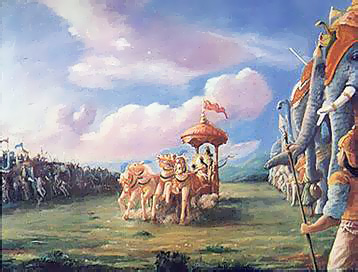
The warriors of both the sides met and settled the rules of the
war. Only equals will fight in personal duels. Those who
surrender, there lives will be spared, No charioteer, animal, or
servants who were not soldiers were to be attacked. These and
some other rules that were usual in a Dharma-Yuddha or a
righteous war were finalised and both the sides agreed to abide
by them.

On the eve of the war, sage Vyasa visited the palace of
Dhritarastra, who was his son, now the terrible days are in
store. All your sons and the kings will be killed soon. This is
settled by fate. It is ordained so, do not be sorry. I shall
grant you your eyesight so that you may witness the war.
Dhritarastra was shaken by the stark words of the sage. He said,
‘My lord, I have been blind all my life. I do not want to see my
sons dying in the battlefield. If someone can give me an account
of the war as it unfolds, I shall be happy. Vyasa said, Sanjaya
would get the power to see everything that happens in the war.
He will be able to see during the day as well as in the night.
He shall be even able to know the thoughts of the persons
engaged in the war. He shall not be tired or exhausted. The
omens are all against the Kauravas." Saying this the great sage
departed.
(After this the entire account of the war is as
related by Sanjaya to the blind king Dhritarastra) Duryodhana was busy arranging his troops in a battle array. He told Dussashan, ‘take care to protect our grandsire, Bhishma. All the chariots and warriors should be placed in such a position to Bhishma. He alone is capable of destroying the entire army of the Pandavas led by Dhristadhyumna. We should pay special attentions to kill Shikhandi. He could be a source of danger to Bhishma. Then (one Akshauhini of Army comprises of 21870 chariots, 21870 elephants, 65610 horses and 109350 men.) akshauhinis of the Kauravas army was arranged in Vyuha (battle array) and one akshauhini was under the direct control of Bhishma. Bhishma chariot was white-silver coloured, it was driven by white horses and his flag was golden, bearing his personal insignia. The Sun was rising in a golden dawn. Karna was the only warrior who had not joined the war. Bhishma’s chief body guard was Ashwathama, who was supported by seven more warriors. Salya and Bhurishrava were among them. Duryodhana’s banner was proudly fixed a top his chariot. Looking at the vast army of the Kauravas, Yudhisthira said to Arjuna. Their army is so huge. They have eleven akshauhinis against them we have only seven. How best can we arrange our army in battle formation. Bhishma is quite formidable. Arjuna said, that he would arrange the army in a ‘Vyuha’ named ‘Vajra’. This was the favourite arrangement of lord Indra. Dhristadhyumna was in the centre of the army. Bhima, Yudhisthira, protected him and Arjuna supported Shikhandi. The most prominent banner in the Pandava side was that of Arjuna, having lord Hanumana himself on it, driven by Krishna, having white horses. All those who knew the reality, saluted Krishna. Krishna said to Arjuna, ‘See the army of the Kauravas, led by your old grandsire. The lion among the Kaurava heroes, is your first victim.
This is the anniversary day commemorating the day that Srimad Bhagavad Gita was spoken by Lord Sri Krishna to His dearmost devotee Arjuna at the place now known as Jyotisar Tirtha amid the waring families of the Kurus and the Pandavas at Kurukshetra. If one wishes one can still go and visit that place and see the monument erected there with Krishna as Parthasarati (the chariot driver) and Arjuna the warrior on their chariot. It is claimed by the ashram who maintain the shrine that the tree that is next to Them is a continum growth of the original tree witness that was there at the actual day of speaking. Traditionally devotees come to Kurukshetra (Dharmakshetra) and recite Bhagavad Gita from early morning until the next morning, perform arati to Bhagavad Gita and to Krishna and Arjuna upon the chariot, offer lamps 'deep daan' at Brahma Sarovar, shloka recitals, shobha yatras and seminars on the significance of the Gita today. Devotees who cannot get to Jyotisar Tirtha remember the blessed event by reciting Bhagavad Gita, and discussing the subject matter of Bhagavad Gita in the association of devotees. Distribution of Bhagavad Gitas' on this day is also a very auspicious activity to perform. What is the Bhagavad
Gita? How should one read the
BG? Owing to the universal message in the BG, many people take to it instinctively. Unfortunately its importance has also given rise to many people speculating and misinterpreting it. In order to protect the trusting people from this kind of cheating, Sri Krishna stresses the importance of Paramapara (disciplic succession) and Guru (spiritual master) in receiving the knowledge of the BG. Who should read the BG?
What is Purpose of the BG? What are the three
paths? The three paths given by Sri Krishna are Karma yoga, Jnana yoga and Bhakti yoga. The first six chapters primarily discuss Karma yoga, liberation by performing prescribed activities. The last six chapters primarily talk about Jnana yoga, liberation by worshipping the Lord through one's intelligence. Ensconced between these two "protective" covers, like a pearl in the oyster, in the middle six chapters, Krishna reveals the most confidential of all knowledge, Bhakti yoga, the path of pure, unalloyed devotional service. He declares this to be the highest, the easiest and the fastest path to Him, and for one who is fortunate to embark on it, the binding illusions of Maya are dispelled in no time. What is Karma yoga?
Performing prescribed duties will earn a person much pious credit, but it will also continue to bind him to the material world. So Karma can be "sakarma" (done in anticipation of enjoying its fruits) or "nishkarma" (detached from the results). In both cases a person is attached to performing the activity. However, when a person performs activities only for the pleasure of the Lord, he has reached the stage of Bhakti. For instance Sadhna (japa, arati, kirtan) are activities performed with no material motives, simply to glorify or remember the Lord. Thus Karma yoga can be used to elevate one self to the position of Bhakti yoga by first performing prescribed activities, then renouncing the fruits of the activities to Krishna and finally by renouncing the activity in itself to Krishna. What is Bhakti yoga?
This verse, often considered to be the summary verse of the entire BG, contains the essence of the existence of a spirit soul. In the material world, trapped in the illusory sense of identifying with the body and its extensions, a spirit soul remains forever bewildered by the duality of existence. However by simply surrendering to Krishna, understanding Him to be the original, primeval cause of all causes and thus worshipping Him without any desires of material benefit, one can easily go back to Him. Bhakti yoga does not mean inactivity. Indeed a bhakta is most active, for he sees all his activities now in relation to the Supreme. But he is detached from the activity and the fruits of the activity, neither happy in success nor distressed in failure, understanding that all this is ultimately for Krishna and coming from Him only. What is Jnana yoga?
When Krishna explains the path of spiritual advancement by knowledge, Arjuna gets confused between the Karma (action) and Jnana (inaction). Krishna explains that one must strive for activities performed in knowledge of Him, which will ultimately lead to Bhakti. Philosophy without faith is speculation, and faith without philosophy is rituals. The two must complement each other. Thus, Krishna once again stresses that the ultimate goal of all transcendentalists is Him. They may reach Him directly by Bhakti or first reach Bhakti through Karma or Jnana. Why has Krishna given
alternatives? In reality. Krishna is offering some thing for every one according to their levels of advancement and inclination. As God, He does not interfere with the free will of a living entity. But as the most compassionate well wisher He wants every one to leave this material world of misery and return to the original spiritual abode. So, for a person attracted to action, there is Karma yoga. For the intellectual there is Jnana yoga. For the mystic there is astanga yoga. The BG meets the person at the level they are in and gradually elevates them to the platform where they become qualified to execute Bhakti yoga, pure devotional service. A very few fortunate souls, by the causeless mercy of Krishna and His devotees, are able to take directly to Bhakti, and for them the way back to Godhead is quick and easy. Bhaktivedanta VedaBase: Bhagavad-gītā As It Is Preface Introduction BG 1: Observing the Armies on the Battlefield of Kurukṣetra BG 2: Contents of the Gītā Summarized BG 3: Karma-yoga BG 4: Transcendental Knowledge BG 5: Karma-yoga — Action in Kṛṣṇa Consciousness BG 6: Dhyāna-yoga BG 7: Knowledge of the Absolute BG 8: Attaining the Supreme BG 9: The Most Confidential Knowledge BG 10: The Opulence of the Absolute BG 11: The Universal Form BG 12: Devotional Service BG 13: Nature, the Enjoyer, and Consciousness BG 14: The Three Modes Of Material Nature BG 15: The Yoga of the Supreme Person BG 16: The Divine And Demoniac Natures BG 17: The Divisions of Faith BG 18: Conclusion — The Perfection of Renunciation
|
